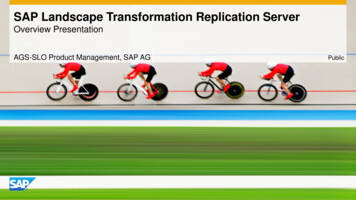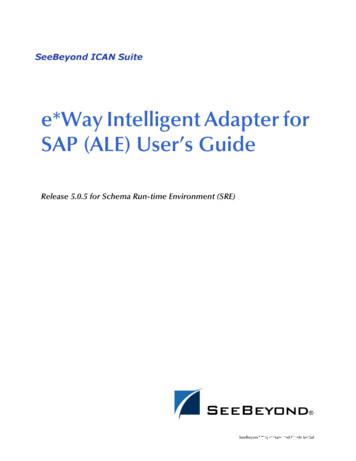SAP Database Administration For Oracle
SAP Database Administration for OracleWhite Paper: Oracle Database AdministrationFebruary 2012
SAP Database Administration for OracleFebruary 2012TABLE OF CONTENTSOVERVIEW . 3FEATURES OF BR*TOOLS FOR ORACLE DBA . 4SPACE MANAGEMENT . 5Analyses . 5Tablespace Management. 5Reorganization . 5Segment Management . 6Functions. 6DATABASE SYSTEM CHECK . 7Functions. 7UPDATE STATISTICS . 8Functions. 8BACKING UP, RESTORING, AND RECOVERING THE DATA . 9Functions. 10COMPUTING CENTER MANAGEMENT SYSTEM . 11ADDITIONAL INFORMATION . 13SAP Library . 13SAP Notes . 132
SAP Database Administration for OracleFebruary 2012OVERVIEWThe database server plays a key role in the SAP server technology. The amount of work involved inmanaging the Oracle database largely depends on the size and the workload. SAP supplies severaldatabase administration tools, BR*Tools, in the standard SAP system package, helping you to manage yourOracle database more easily.You can manage your Oracle database using the following BR*Tools for database administration (DBA): BRSPACEDatabase startup and shutdown, alter database parameters, recreate database, tablespace management,space monitoring and analyses, alter and move data files, table reorganization, index rebuild, export andimport, manage database statistics, manage flashback database, manage online redo log, manage dataencryption BRCONNECTUpdate statistics, database system check, adapt next extents, clean up old logs and traces, and otheradditional functions BRBACKUP, BRARCHIVEBackup and verification of database and offline redo log files BRRECOVERDatabase recovery and restore, as well as disaster recovery3
SAP Database Administration for OracleFebruary 2012FEATURES OF BR*TOOLS FOR ORACLE DBABR*Tools feature several user interfaces, such as a command line and an ASCII user interface with menus.You can also execute some functions using the graphical user interface BRGUI and the Computing CenterManagement System (CCMS). These tools make database administration considerably easier.BR*Tools: Guide you through all tasks, proposing default values and issuing warnings Log all administrative operations in file system and database logs, detailed logs for individual DBA tasks,and the main log for actions affecting database structure Follow SAP norms and recommendations (for example, for tablespace extension) Perform security checks before starting an operation Monitor operations and evaluate the various error messages Execute the entire process required (for example, BRRECOVER automatically performs all steps forrecovering a database after a media error) Let database administrators without in-depth Oracle knowledge perform complex operations such asreorganization Provide an interface to external backup tools using the standard BACKINT interface Identify dependencies using the logs (for example, if the required backup does not exist, BRRECOVERdoes not perform a recovery) Are integrated into the Computing Center Management System (CCMS) Conform to SAP’s ABAP Dictionary Support Oracle databases on raw devices Support Oracle Automatic Storage Management (ASM) Support Oracle Standby configurations Support Oracle Recovery Manager (RMAN) Support Oracle Real Application Cluster (RAC) Support Oracle database appliances like Oracle Exadata Database Machine4
SAP Database Administration for OracleFebruary 2012SPACE MANAGEMENTThe Oracle database is installed in file systems, on raw devices, or in Oracle ASM with the SAP system.Database space management with BRSPACE provides essential functions for: Organization of the database files (number, assignment to tablespaces, distribution on disks, file system,raw device, links to raw devices, ASM disk groups) Monitoring logical objects (tables or indexes) in individual tablespaces and checking free space intablespaces Monitoring storage space allocation of individual logical objects (extents or blocks), extent allocation to anobject, the fill level of segments, and so on If storage problems occur, you can use BRSPACE to solve them by extending a tablespace (that is,increasing the physical storage space allocated to the tablespace) or by performing a reorganization (thatis, redistributing existing free space and allocated space).AnalysesBRSPACE provides several options that help to identify and analyze storage problems in advance. Someoptions let you modify storage parameters automatically to prevent storage problems arising. In this way, forexample, you can considerably reduce the need to reorganize the database.Tablespace ManagementWhen BRSPACE creates new data files, it follows SAP naming conventions and take free disk space intoaccount. BRSPACE determines and displays information about free space on disk volumes and raw disks.Therefore, you can easily and quickly extend tablespaces.ReorganizationDuring a reorganization, the database system can be used for production operation or for all other onlinetransaction processing (OLTP) applications. However, the reorganization puts additional load on the systemand temporarily doubles the space required for reorganized tables. This is why we recommend you to avoidreorganization if possible, or to speed it up, if it becomes necessary.The reasons why you might need to reorganize the database are: Internal fragmentation: fragmentation of table or index data within a block or chaining of data over severalblocks External fragmentation: fragmentation of the extents of a logical object and of the free space within atablespace, maximum number of extents for an object reached You want to transform dictionary managed into locally managed tablespaces. You want to move certain large and heavily used tables into separate tablespaces. You want to convert BasicFile LOBs to SecureFile LOBs You want to compress tables, indexes, SecureFile LOBs There are fragmented tables or indexes in dictionary managed tablespaces that you are still using. Youcan identify these by using the database system check.The aim of reorganization is to speed up data access and to use available space more efficiently. The Oraclepackage DBMS REDEFINITION is used for the online reorganization process that is executed by BRSPACEas a series of steps. The SQL command ALTER TABLE MOVE is used for offline reorganization. The tablesare locked during this procedure. You can modify certain table or index attributes during the reorganizationprocedure.5
SAP Database Administration for OracleFebruary 2012Segment ManagementYou can use BRSPACE to change certain attributes of tables and indexes. You can use BRCONNECT toadapt storage attributes of database objects such as tables and indexes.Functions Displaying disk usage Displaying fragmentation (free space and allocated space) and degree to which tablespaces are filled Computing and displaying database statistics for tables and indexes (individually or for each tablespace) Extending tablespaces Creating and dropping tablespaces Renaming tablespaces and their data files Moving and renaming data files Reorganization (single table and its index, list of tables and indexes, or tablespace), including changes tostorage parameters Moving tables and indexes to other tablespaces during reorganization or rebuild Rebuilding online indexes Shrinking online tables and indexes Using Oracle export/import for data transfer6
SAP Database Administration for OracleFebruary 2012DATABASE SYSTEM CHECKWe recommend you to regularly run the database system check in order to spot problems early. Thedatabase system check with BRCONNECT is also available from CCMS.We recommend you to perform the system check daily, using the automation in the DBA Planning Calendarin transaction DBACOCKPIT to execute brconnect -f check. You then display the check results in theCCMS alert monitor and decide whether to implement any recommendations.Functions Checking space (that is, free space and fragmentation) Checking the results of DBA operations with BR*Tools Monitoring Oracle alert messages Checking Oracle profile parameters Checking physical consistency (that is, availability of data files, control files, and redo log files) Checking missing optimizer statistics Checking specific problem situations based upon SAP’s experience in managing databases Controlling all system checks by one single customizing transaction (for example, thresholds, repeatabilityperiods, error descriptions and corrective actions, Oracle error message checks, and Oracle profileparameters can be added)7
SAP Database Administration for OracleFebruary 2012UPDATE STATISTICSThe Oracle Cost-Based Optimizer (CBO) is activated as standard and is supported by BRCONNECT. TheCBO optimizes data access by gathering database statistics, which it obtains by analyzing table size anddata distribution. You can use CCMS to automatically set up the statistics control table, DBSTATC, as wellas to check and update the CBO statistics. The result is improved database performance.Functions Displaying information about existing statistics Detecting tables that need updated statistics Creating missing statistics for tables and indexes Displaying alert messages for missing statistics for tables and indexes (see “Database System Check”above) Controlling the update procedure by editing the control table DBSTATC Managing table statistics (version management, export/import)8
SAP Database Administration for OracleFebruary 2012BACKING UP, RESTORING, AND RECOVERING THE DATAAs shown in the graphic below, BRBACKUP backs up the database objects (data files, control files, andonline redo log files) and BRARCHIVE backs up the offline redo log files. You can perform a restore andrecover with the SAP tools BRRESTORE and BRRECOVER. BRRESTORE also allows parallel processing(like BRBACKUP). You can call all these tools from the BRGUI or BRTOOLS menu.Oracle DatabaseControl filesData filesOnline redolog filesOffline redolog filesRestore il andsummarylogDetail andsummarylogDetail andsummarylogControl filesData filesOnline redo log filesOffline redo log filesBackup MediaBRBACKUP, BRARCHIVE, and BRRESTORE provide an open interface, BACKINT, enabling you to usenon-SAP backup tools. The official name of this interface is BC-BRI, and it is certified by SAP.The BRRECOVER menu options for restore and recovery are specially designed for ease of use.BRRECOVER provides support in the following important situations: Media error in several files, for example, because of a disk failure. The database is fully recovered up tothe time of the media error. Restoring the entire database or some tablespaces to perform a point-in-time recovery or to reset thedatabase to a previous state Disaster recoveryBRRECOVER evaluates the backup logs and the summary log to decide whether the chosen recovery canbe performed using the selected backups. For example, it determines whether any actions have occurredbetween the time of the backup and the end time of the selected recovery (point in time) that would prevent asuccessful recovery.If BRRECOVER cannot perform a recovery, it rejects the backup selected or the recovery procedurespecified.9
SAP Database Administration for OracleFebruary 2012BRRECOVER can only recover data automatically if BRBACKUP and BRARCHIVE or the BACKINTinterface were used for the backup. In this respect, the SAP tools BRBACKUP, BRARCHIVE, BRRESTORE,and BRRECOVER function as an integrated solution.Functions BRBACKUP: database backup (parallel, restartable, database status is monitored) BRARCHIVE: archiving of offline redo log files BRRESTORE: restore of database and offline redo log files (parallel, restartable) BRRECOVER: complete database recovery, point-in-time recovery, and disaster recovery Backup media management Validity check of all objects in the database (online redo log files, control files, data files) Automatic restore of all required objects (tape request) Support in various situations such as disk failure, point-in-time recovery, resetting the database to aprevious state Support for special database configurations such as standby database. Backup from disk backups to tape (two-step backup) Split-mirror disk backup Standby database backup Completion of partial backups Robot control interface for automatic tape mounting BACKINT interface to commercial backup tools Support of Oracle Recovery Manager (RMAN) for incremental backups Support for Oracle Real Application Cluster (RAC) Support for Oracle Automatic Storage Management (ASM) Support for Oracle appliances such as the Oracle Exadata Database Machine10
SAP Database Administration for OracleFebruary 2012COMPUTING CENTER MANAGEMENT SYSTEMThe Computing Center Management System (CCMS) gives a detailed overview of the DBA actionsperformed using BRBACKUP, BRARCHIVE, BRCONNECT, and BRSPACE. It provides information on theruntime of actions and the amounts of data handled. This means that you can easily plan time and spacerequirements with CCMS.Using the DBA Planning Calendar in transaction DBACOCKPIT – as shown in the graphic below – you canschedule online and offline backups in CCMS, and you can also display the logs of all backups. You can usethe return codes to check whether actions have been successful.SAP tools ensure that information is up-to-date in CCMS. For example, when old file system logs are deletedwith BRCONNECT, the corresponding database tables are also modified to reflect these changes, soenabling CCMS to access up-to-date log information.In addition, you can use CCMS to schedule many BRCONNECT functions, such as updating the Cost-BasedOptimizer statistics or the database system check. The following graphic shows the pop-up to create a newaction:11
SAP Database Administration for OracleFebruary 201212
SAP Database Administration for OracleFebruary 2012ADDITIONAL INFORMATIONSAP LibraryYou can find more information on Oracle database administration and the contents of this document in theSAP Library as follows:All paths refer to SAP NetWeaver 7.3.1. Call up the SAP Help Portal at help.sap.com/nw73 Application Help SAP Library: English.2. Choose SAP NetWeaver Library: Function-Oriented View Database Administration DatabaseAdministration for Oracle.3. Choose one of the following: SAP Database Guide: Oracle CCMS: OracleYou can also find these plus selected extracts from the SAP Library at:www.sdn.sap.com/irj/sdn/ora SAP on Oracle Knowledge Center SAP Documentation inHelp PortalSAP NotesYou can find SAP Notes at:service.sap.com/notes13
www.sap.com Copyright 2012 SAP AG. All rights reservedNo part of this publication may be reproduced or transmitted in any form or for any purposewithout the express permission of SAP AG. The information contained herein may be changedwithout prior notice.Some software products marketed by SAP AG and its distributors contain proprietary softwarecomponents of other software vendors.Microsoft, Windows, Excel, Outlook, PowerPoint, Silverlight, and Visual Studio are registeredtrademarks of Microsoft Corporation.IBM, DB2, DB2 Universal Database, System i, System i5, System p, System p5, System x,System z, System z10, z10, z/VM, z/OS, OS/390, zEnterprise, PowerVM, Power Architecture,Power Systems, POWER7, POWER6 , POWER6, POWER, PowerHA, pureScale, PowerPC,BladeCenter, System Storage, Storwize, XIV, GPFS, HACMP, RETAIN, DB2 Connect, RACF,Redbooks, OS/2, AIX, Intelligent Miner, WebSphere, Tivoli, Informix, and Smarter Planet aretrademarks or registered trademarks of IBM Corporation.Linux is the registered trademark of Linus Torvalds in the United States and other countries.Adobe, the Adobe logo, Acrobat, PostScript, and Reader are trademarks or registeredtrademarks of Adobe Systems Incorporated in the United States and other countries.Oracle and Java are registered trademarks of Oracle and its affiliates.UNIX, X/Open, OSF/1, and Motif are registered trademarks of the Open Group.Citrix, ICA, Program Neighborhood, MetaFrame, WinFrame, VideoFrame, and MultiWin aretrademarks or registered trademarks of Citrix Systems Inc.HTML, XML, XHTML, and W3C are trademarks or registered trademarks of W3C , World WideWeb Consortium, Massachusetts Institute of Technology.Apple, App Store, iBooks, iPad, iPhone, iPhoto, iPod, iTunes, Multi-Touch, Objective-C, Retina,Safari, Siri, and Xcode are trademarks or registered trademarks of Apple Inc.IOS is a registered trademark of Cisco Systems Inc.RIM, BlackBerry, BBM, BlackBerry Curve, BlackBerry Bold, BlackBerry Pearl, BlackBerry Torch,BlackBerry Storm, BlackBerry Storm2, BlackBerry PlayBook, and BlackBerry App World aretrademarks or registered trademarks of Research in Motion Limited.Google App Engine, Google Apps, Google Checkout, Google Data API, Google Maps, GoogleMobile Ads, Google Mobile Updater, Google Mobile, Google Store, Google Sync, GoogleUpdater, Google Voice, Google Mail, Gmail, YouTube, Dalvik and Android are trademarks orregistered trademarks of Google Inc.INTERMEC is a registered trademark of Intermec Technologies Corporation.Wi-Fi is a registered trademark of Wi-Fi Alliance.Bluetooth is a registered trademark of Bluetooth SIG Inc.Motorola is a registered trademark of Motorola Trademark Holdings LLC.Computop is a registered trademark of Computop Wirtschaftsinformatik GmbH.
The database server plays a key role in the SAP server technology. The amount of work involved in managing the Oracle database largely depends on the size and the workload. SAP supplies several database administration tools, BR*Tools, in the standard SAP system package, helping you to manage your Oracle database more easily.
SAP ERP SAP HANA SAP CRM SAP HANA SAP BW SAP HANA SAP Runs SAP Internal HANA adoption roadmap SAP HANA as side-by-side scenario SAP BW powered by SAP HANA SAP Business Suite powered by SAP HANA Simple Finance 1.0 2011 2013 2014 2015 Simple Finance 2.0 S/4 HANA SAP ERP sFin Add-On 2.0
SAP Certification Material www.SAPmaterials4u.com SAP Certification Material for SAP Aspirants at Low cost Home Home SAP Business Objects SAP BPC CPM SAP BPC 7.0 SAP EWM SAP GTS SAP Public Sector SAP Real Estate SAP FSCM SAP FI/CO SAP AC - FI/CO SAP BI 7.0 SAP CRM 5.0
SAP Master Data Governance SAP Information Steward SAP HANA smart data integration SAP Data Hub SAP Cloud Platform Big Data Services SAP HANA, platform edition SAP Vora Customer Experience IoT Workforce Engagement SAP Cloud for Customer SAP Commerce SAP Marketing SAP Asset Intelligence Network SAP Predictive Maintenance and Service SAP .
viii Related Documentation The platform-specific documentation for Oracle Database 10g products includes the following manuals: Oracle Database - Oracle Database Release Notes for Linux Itanium - Oracle Database Installation Guide for Linux Itanium - Oracle Database Quick Installation Guide for Linux Itanium - Oracle Database Oracle Clusterware and Oracle Real Application Clusters
SAP HANA Appliance SAP HANA DB In-Memory A io BI Client non-ABAP (SAP supported DBs) SAP Business Suite SAP Business Suite SAP Business Suite SAP Business Suite SAP Business Suite SAP Business Suite SAP Business Warehouse SAP HANA DB r In-Memory Source Systems SAP LT Replication Ser
ALE/RFC Setup 88 SAP System Type 88 SAP IDoc Version 88 Program ID (SAP to e*Gate) 88 SAP Load Balancing Usage (e*Gate to SAP) 89 SAP Application Server (e*Gate to SAP) 89 SAP Router String (e*Gate to SAP) 90 SAP System Number (e*Gate to SAP) 90 SAP Gateway Ho
Customer Roadmap to SAP Simple Finance - Example " Adopting SAP Simple Finance is a journey - start early" Side-by-side SAP HANA Acceleration SAP HANA accelerators, BW, BPC, GRC SAP Business Suite on SAP HANA SAP ERP on SAP HANA SAP ERP in SAP HANA Enterprise Cloud SAP Accounting Powered By SAP HANA Simple Finance add-on/
SAP Business Suite SAP BW SAP Apps Partner Apps SAP HANA PLATFORM Planning and Calculation Engine Real-Time Replication Services Information Composer & Modeling Studio SAP UI HTML5 Mobile SAP BI 4 SAP ERP SAP CRM SAP SCM SAP PLM SAP SRM SAP Netweaver Predictive Analytics & Business Function Libraries In-Memory























